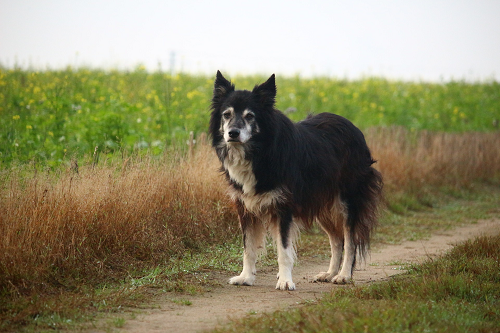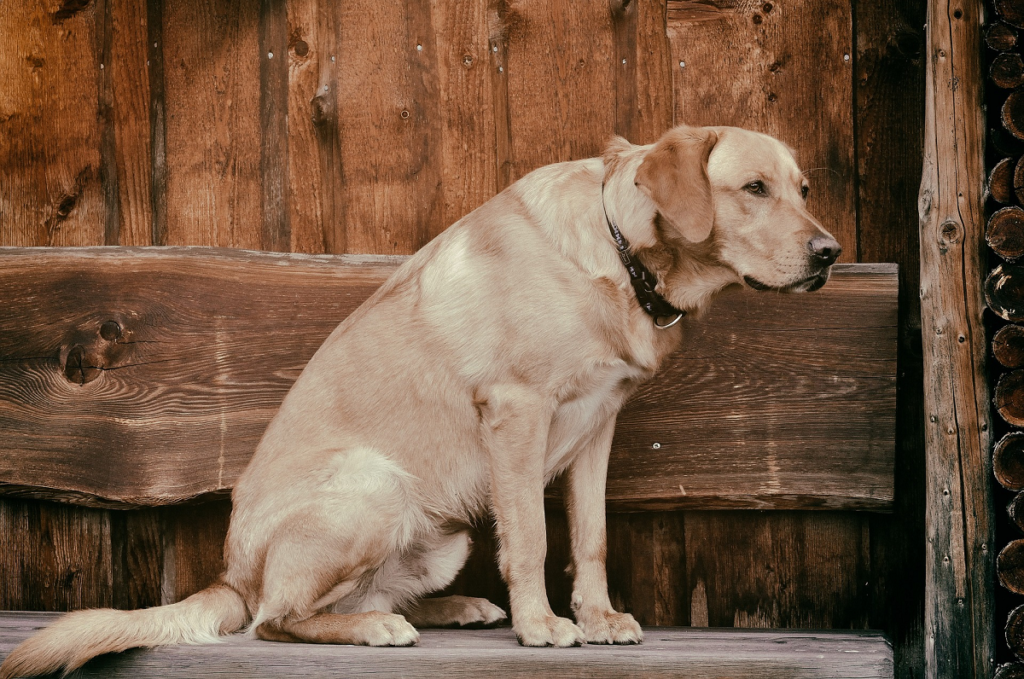Most humans have experienced a sudden dizzy spell, which can come on as mildly as a little disorientation, or quite severely, as if the ground is tilting. Barring obvious external causes such as medication or alcohol, these issues usually stem from a problem in the inner ear, where the sense of balance aligns itself. Surprisingly delicate for its level of importance, this area can send the whole body into a state of vertigo if out of balance.
In dogs, the same problem can occur on a larger scale, particularly as they grow older. This condition, called vestibular disease after the portion of the ear it affects, is an alarming one for pet parents. One moment, their dog is moving, alert, and acting normally, and the next, he’s stumbling erratically or even refusing to stand up from the floor after falling down. This state of canine vertigo can be especially hard to watch for concerned pet parents.
What Is Canine Vestibular Disease?
Just like their human owners, dogs’ vestibular systems are a combination of the entryway to the inner ear (the vestibule, from the word for hallway) and the brain. Both work together as a system in order to orient the body and maintain balance through movement. While most lists of the “five senses” stop after sight, smell, hearing, touch, and taste, the truth is that several other often-overlooked senses – including acceleration and balance – rely on this system. For dogs, this system is a very important one, as they rely on it to maintain the correct rhythm for their paws while walking. A malfunctioning canine vestibular system results in a dog that can no longer maintain his balance or position with accuracy.
Vestibular disease in older dogs is often called, unsurprisingly, “Old Dog Vestibular Syndrome,” as this issue becomes more common in geriatric pooches. While some cases are caused by an external issue, such as medication, illness, or physical trauma, in older dogs it is often idiopathic, meaning spontaneous and without reason. For a concerned pet owner watching a beloved pup stumble, this out-of-nowhere syndrome can be as disorienting emotionally as it is physically for their canine companion.
Signs & Symptoms Of Canine Vestibular Disease in Dogs: What To Recognize
Many of the more alarming effects of vestibular disease can mimic those of more serious diseases, so it’s important that dog owners stay calm and patient if symptoms arise. If a dog shows any of these behaviors, he may be afflicted with canine vestibular disease:
- Stumbling on a flat or otherwise easy-to-navigate surface
- “Drunk” movements that are slow and clumsy for no reason
- A prolonged head tilt that is not an automatic response to a nearby noise
- Eye jittering or quick, jerky movements of the eyes when trying to focus
Vestibular syndrome is rapid-onset, so time is another important factor in determining if a dog is afflicted. Symptoms will not show up gradually over several days or weeks; instead, they will appear between one day and the next, or even over the space of hours.
Vestibular Disease In Dogs: Ruling Out Potential Causes
When a dog has any physical signs of distress, the best course of action is always to take him to a vet or other animal care specialist as soon as possible. Valuable diagnosis time can be saved, however, by ruling out some of the more common triggers for vestibular syndrome symptoms:
- Has he eaten, or had access to, any unfamiliar substances in the last 24 hours? These may include cleaning products, unsafe edibles (e.g. chocolate, grapes, etc.), new houseplants that are poisonous to dogs, health and beauty care items like perfumes, and so on. The symptoms may be triggered by a canine allergic reaction.
- Has he traveled through or spent time in unfamiliar surroundings? The outdoors hold a lot of intriguing exploration opportunities for a curious canine, but there are also ticks, snakes, wasps, mushrooms, and other potentially poisonous plants and animals. If the dog was kept indoors in an unfamiliar home, the dog-sitter or family member might not have known to put harmful items like human medications out of reach.
- Has he had any injuries through accidents in the past 24 hours? A quick tumble off of a deck, or a misfire when playing catch with a hard ball might seem like a harmless bump to an enthusiastic dog. However, just like humans, concussions and head injuries might not show symptoms for several hours, if at all. Additionally, dogs are essentially genetically programmed to hide minor injuries to avoid becoming prey to larger predators in the wild. A dog relies on his owner to notice unusual behaviors that may hint at deeper injuries and wounds.
- Has he had any other uncharacteristic symptoms recently? Obvious, highly visible symptoms like stumbling, falling over, and head-tilting are easy to spot, but they may not tell the whole story. Other symptoms, even minor ones that would otherwise be brushed off, may tell a more complete medical story for more accurate vet diagnosis.
While a vet may have several other questions to ask to help rule out (or confirm) their diagnosis, these five basic answers will help a great deal. Writing down the symptoms and when they started (as opposed to trying to remember and relay at the vet office) may also help.
How Is Canine Vestibular Disease Treated?
If a veterinary office suspects that vestibular issues or old dog vestibular syndrome may be to blame for a dog’s symptoms, they’ll first take his history from his owner. From there, the vet will perform a physical examination on him, looking for particular ‘tells’, such as an irritated or inflamed ear canal, or run bloodwork/biological tests that confirm the presence of an infection or bacteria. Most dog  ears are, thankfully, considerably larger than humans’ ears and therefore physical issues are much easier to spot.
ears are, thankfully, considerably larger than humans’ ears and therefore physical issues are much easier to spot.
During examination, it’s natural and normal for dogs to be a little distressed; if their ear is causing the issue, it’s instinctive to protect it and keep it shielded from anything trying to touch it. If a dog is resisting examination, his owner should talk to him in a low, soothing voice, and rhythmically pet his body to help calm him down. He will be much more familiar and comfortable with his owner, so it’s essential that the owner and the vet work as a team to diagnose and treat his condition.
If no obvious outward signs are visible in the ear, the vet may order additional tests, such as a magnetic resonance image, or MRI, to rule out brain disorder issues. This is particularly true if the vestibular effects don’t remedy themselves in a few weeks; that lingering could point to a more serious health issue that needs to be pinpointed and addressed.
As the diagnosis moves forward, the vet may also recommend supportive therapies to help with the symptoms of vestibular or vestibular-mimicking canine ailments. If a dog cannot stay upright or maintain his head position, he’ll have difficulty with everyday tasks like drinking water from a bowl or eating his food, even if he’s very hungry or thirsty. He may be put on intravenous fluids to prevent dehydration or malnutrition, and may need to spend a few days at an animal care facility for monitoring.
If there is no infection or bacterial cause, the main treatment for vestibular syndrome is a simple, age-old one: time. Most vestibular syndrome appearances in dogs tend to clear themselves up in anywhere from a few days to a few weeks, which is inevitably a relief for owners. While the recurrence likelihood will vary from dog to dog based on his health, it’s not uncommon for dogs afflicted with vestibular symptoms to experience them periodically, particularly if they’re older. This isn’t the fault of the owner, diet, too little or too much exercise, or any other controllable factor: it’s simply a reality for older dogs, and the best thing owners can do is treat the symptoms as directed by their vet.
Is Vestibular Disease In Dogs Contagious?
In multi-dog households, an owner’s first concern after treating “the patient” is typically the safety of their other pets. Since environmental factors such as poisonous plants or bacteria can quite easily infect multiple animals at once, it’s natural (and smart) for pet parents to be cautious. The good news is that traditional vestibular disease and old dog vestibular disease are isolated to the animal they effect. That means that an affected dog – once he gets the green light from the vet, of course – is safe to eat, sleep, and play with his canine siblings.
However, if a dog is struggling to stay on his paws or is nauseous due to head tilt, it might be prudent to keep him isolated or partially isolated as he recovers. Other pets don’t always understand why another dog is vomiting, eating or drinking less, or exhibiting a reduction in energy, so they may play too roughly with him. While “pack” visits and quiet time together could benefit his sense of well-being, his owner should make sure these companion times are brief and well-supervised to keep the recovering dog safe.
Recovering From Canine Vestibular Disease
A full recovery from canine vestibular syndrome takes anywhere from a week to 30 days. Depending on the severity of the bout, owners may need to pick up and carry or assist their pooch when going out for walks. If the dog is reluctant to walk or struggles a  great deal, investing in some “potty pads” could save the carpet or floor from accidents. His instincts may tell him not to relieve himself indoors where he eats, plays, and sleeps, but a physical inability to get outside without falling over could compel him to do so during his recovery period.
great deal, investing in some “potty pads” could save the carpet or floor from accidents. His instincts may tell him not to relieve himself indoors where he eats, plays, and sleeps, but a physical inability to get outside without falling over could compel him to do so during his recovery period.
While the vast majority of dogs with vestibular syndrome make a full recovery within weeks, slight issues may linger for the rest of their lives, such as a minor head tilt or a general “wobble” when standing still. This doesn’t mean they’re in pain or suffering; it’s simply a remnant of an inner ear balance issue. Again, as this issue tends to recur in older dogs, owners should remain vigilant and proactive about contacting their vet if symptoms re-emerge, even if there isn’t a particular medicine or cure waiting at the office. A vet should be a dog’s lifelong medical support, and that means a full and complete record of his illness should always be on-hand at the office, including vestibular concerns.
Preparing The Home for Canine Vestibular Recovery
Whenever possible, the affected dog should be kept in rooms with soft flooring, such as carpeting, area rugs or blankets, to prevent an accidental fall injury. If he is crate-trained, this is an excellent time to use the crate, particularly with a soft blanket or bedding folded beneath him.
Most dogs are concentrating on their own health and well-being at this point, but remember to move slowly and cautiously around any dog in recovery. If he can’t move his head or eyes reliably, he may mistake a friendly presence for a stranger and become hostile. A dog that is feeling weak and vulnerable may not be his normal cheerful, pleasant self, so human caregivers and visitors should always bear that in mind.
Familiar objects – cherished toys, favorite foods, and so on – may provide him with a sense of comfort as he recovers, making him less excitable and therefore less prone to falling injuries. During recovery, pet parents may wish to temporarily disconnect doorbells (or at the very least, put up a sign not to ring the buzzer), as this may help decrease incidences of startling the dog and his subsequent reflex urges to leap up and check the door for the mail carrier or delivery person. Ultimately, it’s all about keeping him calm, relaxed, and laying down as much as possible while he’s on the mend.
Summary: Remaining Proactive For Your Dog’s Vestibular Condition
Vestibular disease in dogs is a common health issue, particularly in older dogs, but it typically presents itself as a very serious issue to a concerned owner. When in doubt, always contact a vet for a comprehensive examination – it will help both owner and canine to sleep more soundly. Staying proactive about fall risk protection, nutrition, and hydration as a dog recovers is the best way for a loving human to support their four-legged friend in vestibular recovery, and time is the best healer as far as this ailment is concerned.
Sources Cited:
- Ward, Ernest, DVM; Updated by Malcom Weir, DVM, MSc, MPH. “Vestibular Disease in Dogs.” VCA Hospitals.com, (no publish date), https://vcahospitals.com/know-your-pet/vestibular-disease-in-dogs. Accessed July 12, 2019.
- Fivecoat-Campbell, Kerri. “Vestibular Disease in Dogs.” PetMD.com, (no publish date), https://www.petmd.com/dog/conditions/neurological/vestibular-disease-dogs. Accessed July 12, 2019.
- Becker, Dr. Karen. “If Your Dog Suddenly Starts Circling or Staggering, This Could Be Why.” Healthy Pets.Mercola.com, (no publish date), https://healthypets.mercola.com/sites/healthypets/archive/2012/06/04/canine-vestibular-disease.aspx. Accessed July 12, 2019.




